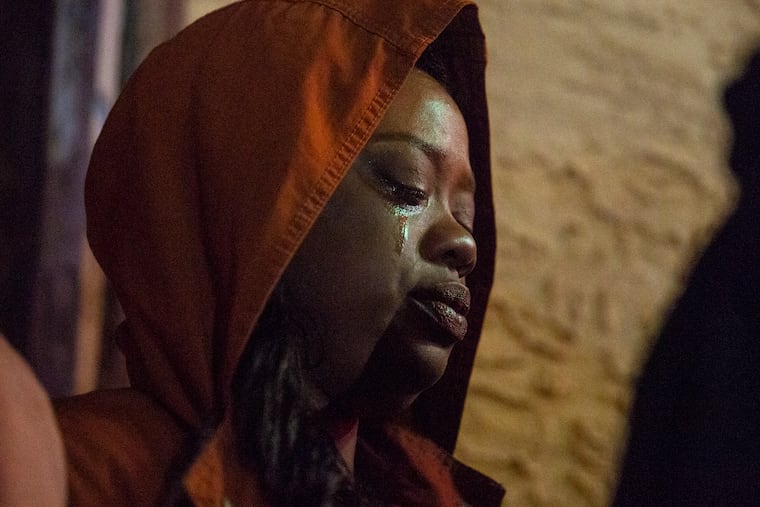Another child in Philly has been shot, so now what? I called our political leaders to ask | Helen Ubiñas
The city has plans and programs to stem the violence. But what can be done now?

I called the governor’s office, the city’s managing director’s office, the District Attorney’s Office, the U.S. Attorney’s Office, and the city controller’s office.
I reached out to the School District’s superintendent and the acting police commissioner.
I had conversations with the council president and the head of the Center City District and the commissioner of Parks and Recreation and community activists and city residents.
To each, I asked the same question:
Now what?
A 10-year-old boy is clinging to life after being shot in the head Wednesday while walking home from school in Frankford, just weeks after a 2-year-old girl in Kensington was fatally shot in her mother’s arms, and an 11-month-old boy was shot in North Philadelphia four times — among the youngest victims of more than 300 people murdered in Philadelphia so far this year.
Again, now what?
Very little of what I heard made me think we have an answer that will make a difference right now.
Here’s what we know:
We know that if these were white victims in Chestnut Hill or Rittenhouse Square or any number of places where we have deemed this kind of staggering loss unacceptable, the reaction would be swift and certain.
We know that whatever antiviolence programs we are using are falling short. There have been nearly 200 shootings of people age 19 and younger so far this year, according to police, 24 of them fatal.
Despite all the city-funded “road maps” to address the violence, we also know that every plan and program is a dead end if each one is strictly a response to the symptoms, not the causes, of violence. We know violence is a historic, systematic, entrenched lack of opportunity. We can stop the violence only when we stop the inequity.
“Yeah, it turns out there are only so many ways to rearrange the deck chairs on the Titanic," said Scott Charles, trauma outreach coordinator for Temple University Hospital. "We’re either going to have to address poverty and its attendant hopelessness, or we’ll just have to wait for the city to reach its natural saturation point with misery.”
Brutal, and true.
The reality is that this fight can’t be won here alone. It’s statewide and national. We can’t wait for a tipping point that isn’t coming — certainly not when we’ve already witnessed babies murdered in their Connecticut elementary school, and some gun-rights activists responding by taunting and attacking the dead children’s families.
That was a theme that came up repeatedly in my conversations: There is legislation that needs to be introduced, laws to be passed, spines — officials call it political will — to grow.
“We need to do a better job of creating a society where [people] have alternative opportunities,” said Gov. Tom Wolf. “… access to health care, good jobs, a life that has hope rather than despair. We have to do a lot of work.”
True. If only that offered even a little solace to people suffering right now.
But I see too many political axes to grind, personal agendas being pursued and territory marked, adults working in silos acting like children while actual children are dying.
There is also, from some corners of the city, a stunning negligence from people waiting for a special invitation to the table. The invitation isn’t coming. All the fine restaurants or fancy new buildings or fashion district grand openings won’t matter if the image of the city is one of unrelenting chaos.
And then there’s the arrogance from those who insist they know what’s best for the community while dismissing huge parts of the city, and keyboard critics who cry that the community isn’t doing its part. Tell that to the mothers working their dead children’s murder cases or the people who stepped up to help find the 2-year-old’s killer.
You know what the mothers and fathers living this reality consistently tell me they want? Whatever it takes. "Law and order,” one father told me. They want to know that when they send their children to school, those children will come back to them.
The family of the 10-year-old, Semaj O’Branty, doesn’t know when, or if, he will be coming home. When I visited with his older brother, Domonte Dark, 24, and Dark’s girlfriend, Angel Amous, they told me that Semaj had just gotten out of emergency surgery to remove a bone in an attempt to reduce the swelling in his head.
Dark, exhausted, sat mostly silent with his head in hands.
Now what? his girlfriend asked softly, considering the question.
“We need everyone’s prayers,” she said.
And they need support through a GoFundMe (https://www.gofundme.com/f/semaj-relocation-fund) to help relocate the family. They are religious, and, God willing, they told me, if Semaj makes it, the family won’t go back to their home. They want to feel safe.
Now what? For now, this is the least we can do.